Here Are the Most (and Least) Loved Buildings in New York City, According to Columbia GSAPP Faculty and Students
Plus, their picks for the most memorable urban views, parks, and museums—and where they would like to live.
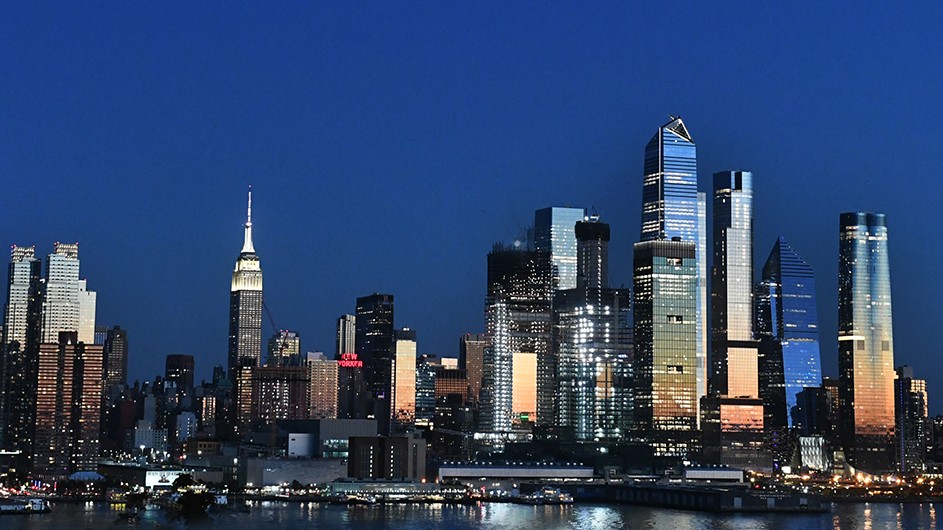
Everyone has an opinion about the best or worst of everything in New York, but perhaps none more so than architects, designers, and planners when it comes to the urban fabric—structures, streetscapes, systems, soaring views.
Columbia News turned to the School of Architecture, Planning, and Preservation to ask Interim Dean Weiping Wu, along with professors and students, their thoughts on various aspects of the city’s built environment, where they go to escape urban chaos, and what they think is the biggest problem New York faces in terms of climate change and environmental impact.
Natalie Bartfay, Student, ’23 Master of Science in Urban Planning
Q. Where is the best view of the New York skyline?
A. I’m partial to the way the Manhattan skyline peeks through the trees on Central Park’s Great Hill, on the West Side between 103rd and 107th streets. Plus, it’s a perfect location for an evening picnic.
Q. What New York museum or cultural institution do you visit again and again?
A. As an urban planning student, it’s probably no surprise that I love the Museum of the City of New York. It’s a wonderful place to learn about the many voices, movements, and events that have shaped our city, and I am especially fond of its permanent exhibit, New York at Its Core.
I also like to visit the Rubin Museum during their Free Friday Nights. It’s a great venue to center myself after a long week, and there always seems to be a fascinating interactive installation. I would be remiss if I did not mention my top New York City institution: the 24-hour diner. My personal favorite? The Flame Diner in Hell's Kitchen.

Q. If you could live anywhere in the city, where would it be?
A. I’m enamored with the city’s small, secluded, and idiosyncratic courtyard housing communities. A few that come to mind are the whimsical Tudor Revival homes of Pomander Walk on West 94th Street, and the Bronx’s cliffside Villa Charlotte Brontë, on the Hudson River, in addition to the gorgeous, 19th-century rowhouses on Astor Row, and Sylvan Terrace, both in Harlem, and, finally, Washington Mews and Grove Court in the Village.
Q. Which New York City park or public space does the best job of offering solitude and a respite from urban chaos, as well as an abundance of greenery in a beautifully designed natural setting?
Fort Tryon Park in northern Manhattan is a gem. It’s the home of the Met Cloisters, and also boasts beautiful, meandering walkways and an incredible view of the Palisades across the Hudson River. The park is both magical and accessible.
Pelham Bay Park in the northeastern Bronx is underrated. It’s three times the size of Central Park and home to Orchard Beach and the Bartow-Pell Mansion, as well as being adjacent to the small coastal community of City Island—a great place to end the day with friends and a big plate of fried seafood.
Q. What do you think is the biggest problem the city is facing in terms of climate change/environmental impact, and how can it be solved?
A. Together, we New Yorkers have to put forward ambitious climate resiliency and adaptation measures, especially in terms of environmental justice. Becoming a net-zero, all-electric city will be difficult to achieve as, currently, 80 to 90% of New York City’s electricity is from fossil fuels.
To address this, we must rapidly develop onshore and offshore wind power, solar, and other renewable sources of energy; invest in large-scale electricity storage; convert household gas utilities to electric; and expand and innovate on how we get electricity to the city and into our homes.
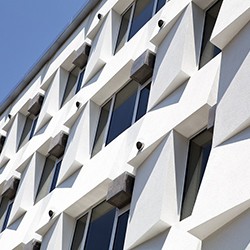
Patrice Derrington, Holliday Associate Professor; Director, Real Estate Development Program
Q. What is your favorite building in the city, and why?
A. 500 Park Avenue (the original corner pieces), between 58th and 59th streets, is a beautiful and understated example of modernism. And beyond mere aesthetic appeal, the affordable and passive house residential buildings of architect Chris Benedict, such as Knickerbocker Commons in Brooklyn, are truly inspirational.
Q. Your least favorite building in the city, and why?
A. Any of those gold-coated ones, for obvious reasons.
Q. What building, or part of the city's built environment, do you want to redesign every time you see it?
A. I don't presume to outdo any architect in the challenging task of creating the built fabric of New York City. Though I would like to redesign the infrastructure below the streets. Its continued lack of accessibility is strangely antediluvian for such a progressive city.
Q. Where is the best view of the New York skyline?
A. From an aircraft approaching.
Q. What New York museum or cultural institution do you visit again and again?
A. The Museum of Modern Art and the Isamu Noguchi Museum in Queens.
Q. If you could live anywhere in the city, where would it be?
A. I have done and desire to live in all the various parts of the city; living within the 'hood is the only way to understand it.
Q. Which New York City park or public space does the best job of offering solitude and a respite from urban chaos, as well as an abundance of greenery in a beautifully designed natural setting?
A. Central Park is phenomenal in its scale, variety, and accessibility. Its population and their various activities on holidays are an authentic manifestation of the democracy to which America aspires.
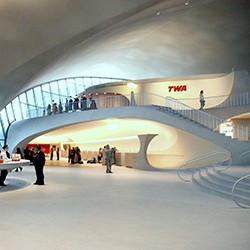
Ryan Devlin, Visiting Assistant Professor, Urban Planning Program
Q. What is your favorite building in the city, and why?
A. One of many that I love is Eero Saarinen's TWA Flight Center at John F. Kennedy International Airport. It is so emblematic of the romance and excitement of the jet age, and unlike almost any other building in the city.
Q. Your least favorite building in the city, and why?
A. The entire Hudson Yards complex. It's cold, bland, predictable, and overly sanitized—the opposite of everything that makes New York great.
Q. What building, or part of the city's built environment, do you want to redesign every time you see it?
A. Penn Station. Especially considering the majesty of the original McKim, Mead & White station. There is a great quote about the difference between the old and current Penn Station by art historian Vincent Scully: "One used to enter the city like a god. One scuttles in now like a rat." The new Moynihan Train Hall is an improvement, but we'll never recapture what was lost when the original Penn Station was demolished.
Q. Where is the best view of the New York skyline?
A. Sunset Park in Brooklyn has one of the best views in the city. You see the entire Upper Bay, from the Statue of Liberty to Lower Manhattan up to Midtown. Second place would be the view from the subway as it crosses the Manhattan Bridge. No matter how many times I take that ride, I always get up to take in the view.
Q. What New York museum or cultural institution do you visit again and again?
A. The Museum of the City of New York always has interesting exhibits about the city's history and culture. Plus, it has probably the best gift shop in the city for urbanist nerds.
Q. If you could live anywhere in the city, where would it be?
A. I love where I currently live—Hell's Kitchen. It's a neighborhood with a long, working-class history that retains some of its old character, even though, like most of Manhattan, it has experienced intense gentrification. The only thing I'd change is a bigger apartment—but that's every New Yorker!
Q. Which New York City park or public space does the best job of offering solitude and a respite from urban chaos, as well as an abundance of greenery in a beautifully designed natural setting?
A. Central Park checks all of these boxes. The southern sections can be packed with tourists, but north of the reservoir, the crowds thin out and you get some more peace and quiet.
I, however, am not one who craves natural settings or respite from the city. When I want to recharge, I like spending time in crowded, dynamic public spaces. People-watching in Union Square Park or Washington Square Park is a great way to spend a weekend afternoon.
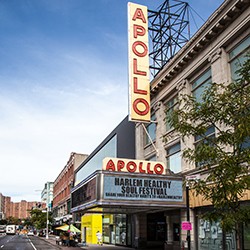
Gene Han, Student, ’22 Master of Architecture Program
Q. What is your favorite building in the city, and why?
A. It feels impossible to select a favorite, but one is definitely the Apollo Theater on 125th Street. Every time I see it, I imagine how so many of my favorite musicians (Billie Holiday, Lauryn Hill, Miles Davis, Thelonius Monk) were all in that same space, at different times. The Apollo has this glow and allure at night, as if the past, present, and future are all happening there simultaneously. It’s a beautiful example of how space is used and activated by people, and that architecture is only an infrastructure.
Q. Your least favorite structure in the city?
A. The Vessel in Hudson Yards.
Q. Where is the best view of the New York skyline?
A. The best paid view of the city skyline is on either the Staten Island or Soundview ferry routes (only $2.75!). Best free view (of Manhattan): Greenpoint Terminal Market in Brooklyn.
Q. If you could live anywhere in the city, where would it be?
A. Anywhere that has natural light for a photography studio/fabrication shop. (And also an in-unit laundry, close to a subway line, and ma and pa restaurants).
Q. What New York museum or cultural institution do you visit again and again? And which New York City park or public space does the best job of offering solitude and a respite from urban chaos, as well as an abundance of greenery in a beautifully designed natural setting?
A. I think the most important cultural institution in the city is also the most important public space—the Community Garden and the Bronx Documentary Center in the South Bronx. The two spaces are next to each other, and work closely to bring a safe, beautiful, and accessible area to everyone. I want to take this moment to acknowledge the important work Marty and Francine Rogers at the garden, and Columbia Journalism School Adjunct Professor Michael Kamber and his team at the center are doing.
These places not only bring the local community together, but also make it closer. They constantly remind me why it’s not the design of architecture that deems a space successful, but the people and the relationships that are created in the space.
Q. What do you think is the biggest problem the city is facing in terms of climate change/environmental impact, and how can it be solved?
A. I have only lived in New York for three years, but an immediate issue that we experienced recently was the flooding from Hurricane Ida. As designers, we need to configure our built environment to be resilient to unprecedented living conditions. We need to make sure everyone has not just a home, but one that is safe and capable of enduring a great deal of rain.
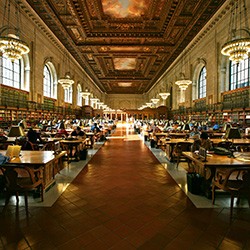
Andrés Jaque, Associate Professor; Director, Advanced Architectural Design Program
Q. What is your favorite building in the city, and why?
A. The main branch of the New York Public Library, on Fifth Avenue between 41stand 42nd streets. It is an extraordinary example of how architecture can contribute to publicness, through both the preservation and the challenging of knowledge. But beyond that, the building is a space of social inclusivity, and the architecture—its dimensions, its materiality—plays a crucial role to make that possible.
Q. Your least favorite building in the city, and why?
A. I believe we architects must be critical of high-end, pencil towers like 432 Park Avenue (56th-57th streets), and the politics to which they contribute. They are designed—even at the level of their constructive detailing, and in the selection of their materials—as devices that promote segregation, and an unequal distribution of resources and vulnerabilities. These buildings mark the need for architecture to abandon a culture of exploitation, to become a force for mutual care.
Q. What building, or part of the city's built environment, do you want to redesign every time you see it?
A. The United Nations. I would love to work on the redesign of the UN, so that it could be transformed into an accessible and permeable space, as a part of the city integrated in its ground level and pedestrian life, instead of being a gated and secured enclave, with a monumental car traffic circle at its entrance, and high fences all around.
Q. Where is the best view of the New York skyline?
A. We are all addicted to skyline views, but I prefer close, street-level views. This is where the richness of a city like New York is made manifest.
Q. What New York museum or cultural institution do you visit again and again?
A. I love New York's network of small, independent art spaces: Light Industry, Artists Space, Storefront for Art and Architecture, Reena Spaulings, Leslie-Lohman Museum, and the Drawing Center.
Q. If you could live anywhere in the city, where would it be?
A. I keep moving every two or three years to a different part of the city. In a place like New York, I want to be a nomad.
Q. Which New York City park or public space does the best job of offering solitude and a respite from urban chaos, as well as an abundance of greenery in a beautifully designed natural setting?
A. I like Riverside Park. More than a park, it is a large section of Manhattan. For me, the escape from metropolitan chaos is an even greater dose of metropolitan chaos.
Q. What do you think is the biggest problem the city is facing in terms of climate change/environmental impact, and how can it be solved?
A. Segregation. The prices of homes are so high, and so controlled by regimes of high-endocracy, that much of the city’s societal richness has been displaced in the last two decades. A city where everyone is welcomed is a much better place to live in.
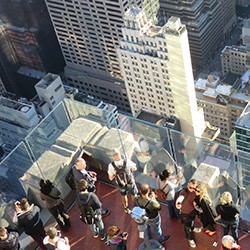
Javier Ortiz, Student, ’22 Master of Science in Architecture and Urban Design
Q. What is your favorite building in the city, and why?
A. The Solomon R. Guggenheim Museum, the last major project designed and built by Frank Lloyd Wright, is one of my favorites. The continuous ramp that uncoils upwards along the walls of the atrium is very compelling. It allows one level to flow into another.
Q. What building, or part of the city's built environment, do you want to redesign every time you see it?
A. The streetscape in Harlem stood out to me when I first came to New York. It is similar to other neighborhoods in that there is a lack of green spaces and canopy coverage, with limited access to riverfronts. It is important to address these environmental injustice issues, and create design solutions with the people of these neighborhoods.
Q. Where is the best view of the New York skyline?
A. Top of The Rock, the observation deck on top of Rockefeller Center, provides unforgettable views. Many famous landmarks can be seen from there: Empire State Building, Chrysler Building, One World Trade Center, and Central Park.
Q. What New York museum or cultural institution do you visit again and again?
A. El Museo del Barrio is one of the most unique places to visit in the city. You are able to visualize and understand Latin American culture through the paintings, sculptures, photographs, films, and household implements on display.
Q. If you could live anywhere in the city, where would it be?
A. I would not change the neighborhood I live in. Harlem made me feel like I was back home. The moment I step out of my apartment building, I see local street vendors selling tamales, fruit, juice, and other appetizing foods that are not found anywhere else in the city.
Q. Which New York City park or public space does the best job of offering solitude and a respite from urban chaos, as well as an abundance of greenery in a beautifully designed natural setting?
A. Central Park is definitely one, but also Freshkills Park in Staten Island. They both support richly diverse habitats for wildlife, birds, and plant communities, and provide extraordinary natural settings for recreation.
Q. What do you think is the biggest problem the city is facing in terms of climate change/environmental impact, and how can it be solved?
A. Coastal resiliency and environmental justice. Because of its heavily utilized shoreline and broad coastal terrain, New York City is extremely vulnerable to coastal storm flooding. There are projects under development to address these issues; however, we also need to look beyond that, and ask who is being most impacted, and why? Generating solutions that will not lead to gentrification or displacement is essential.
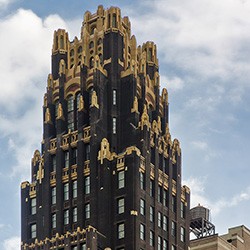
Jorge Otero-Pailos, Professor; Director, Historic Preservation Program
Q. What is your favorite building in the city, and why?
A. As an artist, architect, and preservationist who makes artworks out of dust from building facades, I love the 1924 American Radiator Building on 40th Street across from Bryant Park. It is the first black skyscraper. The color choice was symbolic, celebrating the airborne pollution produced by the products (boilers and radiators) manufactured by the company. This pollution turned every building in New York City a shade of black, so the building’s designers, Raymond Hood and André Fouilhoux, embraced it.
Q. What building, or part of the city's built environment, do you want to redesign every time you see it?
A. Low Library. My redesign would entail preserving the dust on its facades. It has some beautiful stains of time.
Q. Where is the best view of the New York skyline?
A. Driving toward the city on Interstate 495 from Long Island. You can grasp all of Manhattan in your windshield as you head toward it.
Q. What New York museum or cultural institution do you visit again and again?
A. The Hispanic Society. Their collection of paintings by Joaquín Sorolla mesmerizes me. His mastery of light is unrivaled.
Q. If you could live anywhere in the city, where would it be?
A. I’d live inside the Statue of Liberty. It’s a nice fantasy, although in reality, it would be a nightmarish commute up to Columbia.
Q. Which New York City park or public space does the best job of offering solitude and a respite from urban chaos, as well as an abundance of greenery in a beautifully designed natural setting?
A. Bryant Park is my favorite. It is a little oasis in the middle of the hustle and bustle. Plus, you can see some great architecture there while sitting and sipping on the perfect cup of coffee.
Q. What do you think is the biggest problem the city is facing in terms of climate change/environmental impact, and how can it be solved?
A. Existing buildings are the biggest greenhouse gas emitters—back to the boilers we started with. We can make a huge difference if we educate the next generation to value the existing built environment enough to invest their creative energies in redesigning it sustainably.
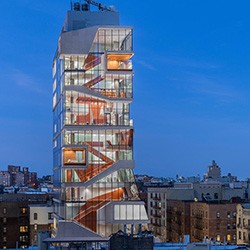
Douglas Woodward, Adjunct Professor, Urban Planning Program
Q. What is your favorite building in the city, and why?
Focusing on overlooked architectural interiors, I’d pick two: the Edgar Kaufmann Conference Room at the Institute for International Education, across from the UN—the only space in the city by my favorite architect, Alvar Aalto; and the reconstruction of the Weil-Worgelt Study by the Parisian decorating firm Alavoine, at the Brooklyn Museum.
Recent building: The University is lucky to have the beautiful Roy and Diana Vagelos Education Center by Diller Scofidio + Renfro at Columbia University Irving Medical Center, with its brilliant, transparent, sectional design parti.
Q. Your least favorite building in the city, and why?
A. Surprisingly, it’s designed by a very fine theater architect, the late Hugh Hardy—the Brooklyn Metroplex on Court Street. A jumble of clashing styles, decorative elements, and materials, it’s a shock after his delicate work on the Claire Tow Theater at Lincoln Center, and his robust renovation of the Harvey Theater at the Brooklyn Academy of Music.
Q. What building, or part of the city's built environment, do you want to redesign every time you see it?
A. The New York City subway, despite recent station improvement efforts, the well-designed first phase of the Second Avenue subway, and the Arts for Transit Program contributions. I worked on the redesign of the Columbus Circle station (which has a landmarked tile wall), but the general incoherence of the station plans, still-incomplete system accessibility, dangerous blind spots, and disastrous maintenance are always disheartening.
Q. Where is the best view of the New York skyline?
A. From a west-banking plane making a wide turn at night to a landing approach at John F. Kennedy International Airport, with a point-blank, rapidly changing view of Manhattan.
Q. What New York museum or cultural institution do you visit again and again?
A. Since my first visit for a fourth-grade class trip, and repeatedly over the years—the Metropolitan Museum of Art, and especially the room with the Vermeers. If they remount the wonderful, 15th-century wood sculpture, Portrait of a Zen Master, missing from its perch in the Asian Art Galleries for some years, it would be even better.
Q. If you could live anywhere in the city, where would it be?
A. I’ve lived in Brooklyn Heights for 40 years, and when the Clark Street Station elevators start operating again, I’ll be happy to stay right where I am.
Q. Which New York City park or public space does the best job of offering solitude and a respite from urban chaos, as well as an abundance of greenery in a beautifully designed natural setting?
A. The Brooklyn Botanic Garden, which has an array of beautiful spaces for every mood and desired degree of companionability.
Q. What do you think is the biggest problem the city is facing in terms of climate change/environmental impact, and how can it be solved?
A. Flooding is the biggest problem for low-lying cities like New York. One of the things that should be done is to resolve not to rebuild communities as they become overwhelmed by sea rise and constant flooding, but rather, enhance near-edge, managed retreat strategies that better protect the shorelines in highly vulnerable frontline areas.
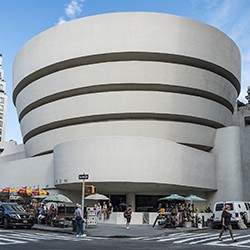
Weiping Wu, Interim Dean; Professor; Director, Urban Planning Program
Q. What is your favorite building in the city, and why?
A. The Guggenheim Museum by Frank Lloyd Wright. Its modern and crisp geometric shapes have endured the test of time. On each visit, I find a unique angle or space, around or inside, that has missed my eyes before. Together with the East Building of the National Gallery of Art in Washington, DC, designed by I. M. Pei, they are my favorite museum buildings.
Q. What building, or part of the city's built environment, do you want to redesign every time you see it?
A. I use Penn Station a lot and find it lacking. Granted, the new Moynihan Train Hall is airy, but trekking indoors between the old and new station buildings remains a dreary experience. I cannot help thinking about the underground pathways of the Hong Kong MTR in Kowloon, and wishing for instant teleporting.
Q. If you could live anywhere in the city, where would it be?
A. The East Village. Ideal urban living, with intimate street scales and variegated shop spaces. Then there are the ethnic restaurants with seemingly endless choices.
Q. Which New York City park or public space does the best job of offering solitude and a respite from urban chaos, as well as an abundance of greenery in a beautifully designed natural setting?
A. I have a soft spot for Riverside Park. Aside from the spectacular waterfront view, it packs a rich array of natural and built sceneries. A short nature hiking path, shaded walking trails, a tree-lined broad walkway, dog park, tennis courts, and skate park—all in this four-mile urban strip.
Q. What do you think is the biggest problem the city is facing in terms of climate change/environmental impact, and how can it be solved?
A. Sea-level rise. A combination of sea-level rise and storms will affect a large portion of all five boroughs of the city. You can see an example of projected flood risk levels by GSAPP urban planning students here. Addressing the challenge requires a host of actions, ranging from enlisting nature as GSAPP Professor Kate Orff envisions, to considering climate change at the building scale, to managed retreat with community planning. Our faculty and students are leading the research and dialogue.